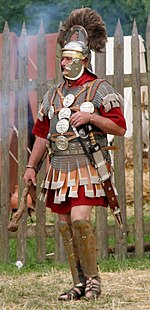Primus pilus

The Primus Pilus ( Latin primus "the first", and pilus "from the Manipel of the Triarians ") was the highest-ranking centurion of a Roman legion , who led the 1st centurie and the 1st cohort . It was also an outstanding honor that was associated with considerable material privileges and was usually only awarded for the final year of service.
function
Like the senior leaders of the other nine cohorts, the primus pilus was a pilus prior and was thus in command of the first centurie and cohort. As the highest ranking centurion, he was also the spokesman for the centurions and took part in the deliberations of the legate's staff . He was responsible for protecting the legionary eagle . As a rule, only deserving men in the position of pilus from the circle of the Triarians or, less often from the circle of the Principes, were promoted to the primus pilus . They received ten to thirty times the pay of a simple legionnaire. A primus pilus who reached a second term of office was given the title of primus pilus bis ; all those who had exercised the function were given the title of primipilaris .
This extraordinarily prestigious position, which also requires a minimum age of 50 years, was usually only achieved by a centurion - if at all - in the last year before being discharged. With a discharge bonus of around half a million sesterces , a Primus Pilus had a good chance of attaining the knighthood and holding important positions in the (provincial) administration. After the 1st century there are examples of the rise of a primus pilus to camp prefect or tribune . The son of a Primus Pilus also has a good chance of making a career in the Legion as a high-ranking centurion or in administration. In the hierarchy of a legion, the primus Pilus occupied the fourth highest position.
literature
- Brian Dobson : The Significance of the Centurion and 'Primipilaris' in the Roman Army . In: Rise and Fall of the Roman World II 1 (1974). Pp. 392-434.
- Brian Dobson: The Primipilares. Development and importance, careers and personalities of a Roman officer rank. Rheinland-Verlag, Cologne 1978, ISBN 3-7927-0251-7
- Alfred von Domaszewski : The hierarchy of the Roman army . 3rd edition (reprint of 2nd edition 1967). Introduction, corrections, and addenda by Brian Dobson. Böhlau, Bonn 1981, ISBN 3-412-05280-9 .
- Yann Le Bohec : The Roman Army. From Augustus to Constantine the Great. Steiner, Stuttgart 1993, ISBN 3-515-06300-5 ( excerpts from googlebooks ).
- Gabriele Wesch-Klein : Social aspects of the Roman army in the imperial era. Steiner, Stuttgart 1998. ISBN 3-515-07300-0 (= Habil. Heidelberg 1995).
Remarks
- ^ Yann Le Bohec: The Roman Army. From Augustus to Constantine the Great. Stuttgart 1993, p. 242.
- ↑ a b Nigel Rodgers: The Roman Army. The legions of the ancient world power and their campaigns. Vienna 2008, p. 22.
- ^ Yann Le Bohec: The Roman Army. From Augustus to Constantine the Great. Stuttgart 1993, p. 32 and 47 f.
- ^ Yann Le Bohec: The Roman Army. From Augustus to Constantine the Great. Stuttgart 1993, p. 46.